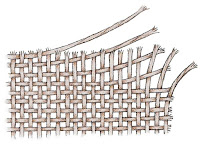Fabric classification
Fabrics can be divided into three
basics types: woven, knitted, and non woven
Woven fabrics
Woven fabrics are produced by
interlacing of two set of yarns which are perpendicular each other in a loom. The
length-wise yarn is called warp or ends. The width-wise yarn called weft,
fillings, or picks. Edges of the fabric width are called selvages. The purpose
of having selvages is to prevent tear of the cloth during finishing processes. Yarn
density in textile is a measure of fabric quality. Therefore, the higher the
number of yarns per inch results in a better quality fabric.
Weaving preparation
Before weaving process, there is
a preparation process for warp and weft yarn. The flow process of waving is a below:
Warp yarns are prepared through the process of warping, sizing and typing in, and then warp boom is put the back of the loom, or rewinding for shuttle less loom, and then put them at the side of the loom accordingly
Next step is weaving process, either using the conventional loom with shuttle which carries picks interlace with warp yarns or shuttle less loom (gripper, or water jet loom). The result of the weaving is called grey fabrics (unfinished fabrics)
In the old days, weaving is done
by using what so called “hand loom”
After revolution of industry, weaving machine was invented called as conventional loom which using shuttle to carry the weft yarn interlace with warp yarn. Nowadays, much further advance technology used to innovate the weaving machine. Then, consecutively found new machinery such as, automatic shuttle change loom, automatic cop change loom, projectile (gripper) loom, rapier loom, water jet loom and air jet loom.
The goal of technology innovation in wearing is mainly to increase productivity, increase efficiency, reduce the wastage of yarn during weaving, and decrease manpower to handle the machine which means one operator may be can handle more than 20 looms.
Weaving mechanism
Weaving is carried out on a
machine traditionally known as a loom, but the term weaving machine has been
used in more recent y years to indicate the high standard of precision
engineering that is used in its manufacture today.
 In pic beside, shows a cross
section through a typical loom, with the warp ends being contained on the
weaver’s beam at the back of the loom. From this point, each end successively
passes through the eye of a heald (with group of healds being mounted within
heald frames) and through the gaps (known as dents ) between the wires of the
reed, which is basically a closed comb. In front of the reed, the warp and weft
combine at the fell to form fabric, which is then drawn forward to be stored on
the cloth roller.
In pic beside, shows a cross
section through a typical loom, with the warp ends being contained on the
weaver’s beam at the back of the loom. From this point, each end successively
passes through the eye of a heald (with group of healds being mounted within
heald frames) and through the gaps (known as dents ) between the wires of the
reed, which is basically a closed comb. In front of the reed, the warp and weft
combine at the fell to form fabric, which is then drawn forward to be stored on
the cloth roller.
Basic weave
There are three basic weaves:
plain, twill, and satin. Other weaves are descendant (elaboration ) of the
three weaves
Plain
Plain weave: the simplest form of
weaving a pick (filling yarn) passes over the first end (warp yarn), under the
second and on continuously, over one end and under the next. The next pick
alternates, passing under the first end, over the second and on continuously
under and over each end. Each filling row alternates, thus extending the
fabric. Also called a one up one down weaves
Twill
Twill is a general term for woven
fabric made with a twill weave, a basic weave characterised by diagonal lines
on the face of the fabric. Twill can be 2/1 or 3/1
Satin
Satin is a smooth strong,
lustrous satin weaves fabric made with silk or manufactured filament yarns. In
the warp face satin, the most common, the filling yarns cross over one and under
several warp yarns, thus mainly the wrap yarns are visible on the face. In a
filling face satin, the filling yarns cross under one and over several warp
yarns thus the mainly the filling yarns are visible on the face. Some satins
have a filament yarn face and spun yarn back







